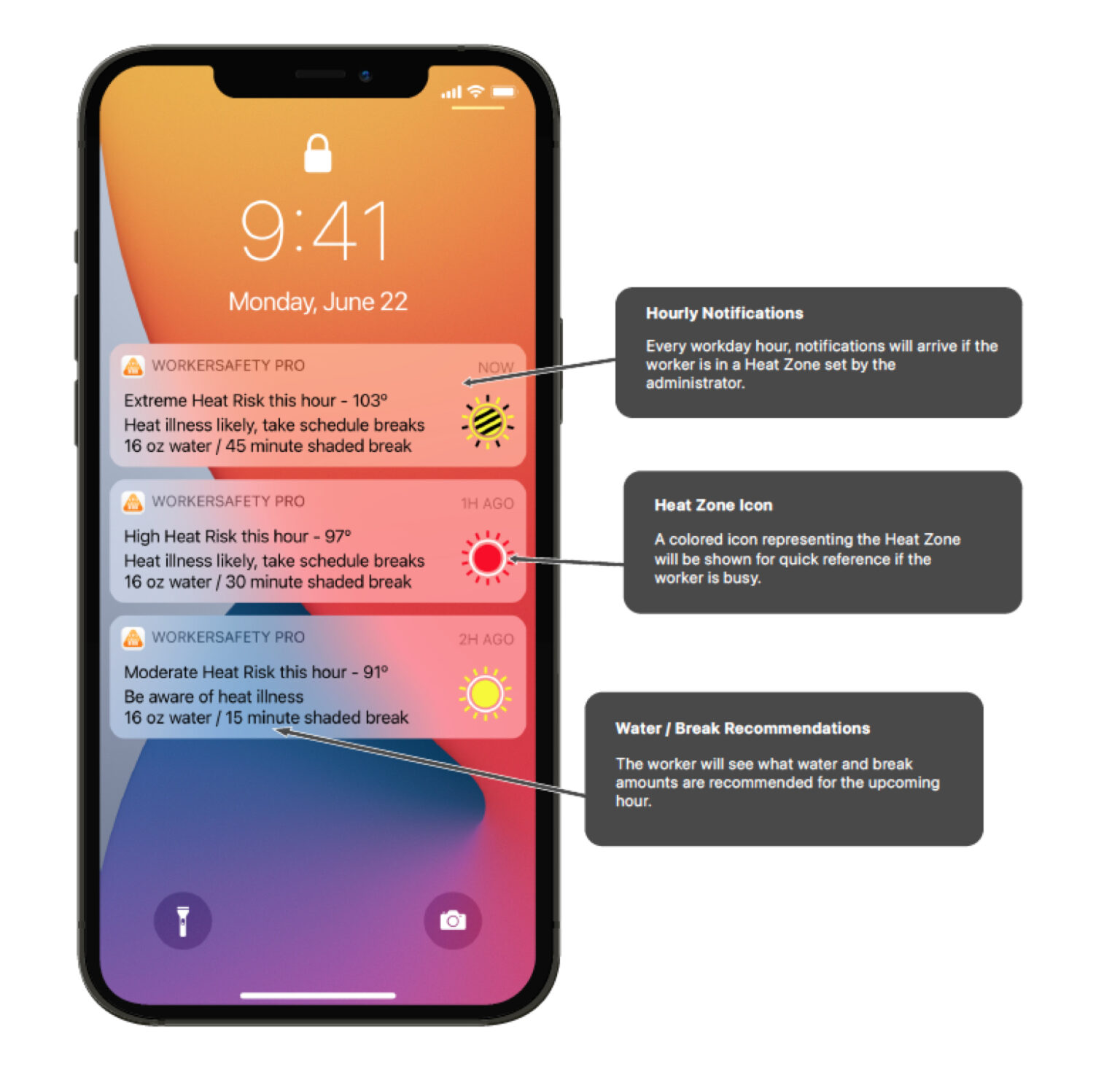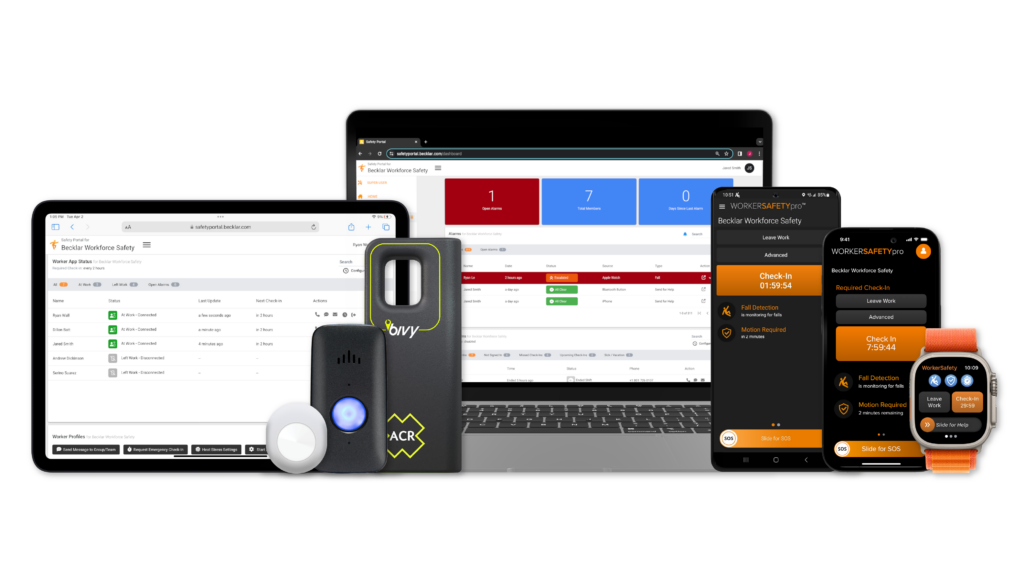Protecting Workers in the Heat with Digital PPE™
Becklar Workforce Safety’s heat stress monitoring provides a robust framework for ensuring worker safety, and reduce the risks and costs associated with heat-related injuries.
Temperatures are warming up and, as much as we all love the summer months, they can also bring potential risks for thousands of employees that work essential jobs outdoors in the heat. We covered this in-depth in our recent webinar about Heat-Related Illness. That includes construction workers, roofers, solar panel technicians, landscapers, farmers, surveyors, window washers, etc., who are all now at a risk for heat-related illnesses and injuries such as dehydration, heat stress, and heat stroke.
At Becklar Workforce Safety, our goal is to protect workers everywhere. We are constantly innovating and updating our industry-leading safety solutions with the most accurate and effective data. We provide a holistic approach to workforce safety, with a complete set of flexible solutions including mobile applications, devices, management dashboards and monitoring services.
According to OSHA (the Occupational Safety and Health Administration), “Heat is the leading cause of death among all weather-related phenomena in the United States.” In addition, the Bureau of Labor Statistics estimates over 3 ,000 heat-related work injuries every year in the United States. These injuries lead to an average of two days off work, resulting in increased operating costs, reduced productivity as well as impacting the health and safety of workers.
3,000 heat-related work injuries per year
Heat-Related Stress and the Labor Force
The latest safety protocol that has been added to Becklar’s WorkerSafety Pro app is heat stress monitoring. This advanced heat safety protocol determines the employee’s heat stress zone if they are working outdoors. Using an advanced algorithm, we calculate the Wet Bulb Globe Temperature (WBGT) for the most accurate representation of what workers actually experience in hot environments. WBGT is a composite temperature used to estimate the effect of temperature, humidity, wind speed, and solar radiation on an individual. Unlike standard temperature readings, the WBGT provides a more comprehensive measure of heat stress on the body. It considers to following:
- Dry Bulb Temperature: The air temperature measured by a standard thermometer.
- Wet Bulb Temperature: The temperature a thermometer reads when its bulb is covered with a water-soaked cloth and exposed to airflow, reflecting the cooling effect of evaporation.
- Globe Temperature: The temperature inside a blackened, hollow, thin copper sphere, which measures radiant heat.
By integrating these factors, WBGT offers a precise understanding of the heat strain on workers, ensuring appropriate safety measures are implemented.
The Role of CAF and Exertion Levels
In addition to WBGT, our updated safety protocols allow organization administrators to set various work factors, including a Clothing Adjustment Factor (CAF) and exertion levels.
Clothing Adjustment Factor (CAF): This factor accounts for the type of clothing workers wear, which can significantly impact heat retention and dissipation. For example, heavy or impermeable clothing increases heat stress, while lightweight, breathable clothing reduces it.
Exertion Levels: Exertion levels refer to the intensity of physical activity performed by workers. Higher exertion levels increase body heat production, requiring more frequent breaks and higher water intake to prevent heat-related illnesses. These levels are reflected in our online Safety Diagram, helping to adjust water and break recommendations based on activity intensity.
By taking these factors into account, along with WBGT, companies can customize alerts and recommendations to workers to ensure their safety and minimize the risk of heat-related injury.
Heat Zones and Recommendations
The WorkerSafety Pro app categorizes heat stress into different zones, providing specific recommendations for each:
- No Heat Risk: When the WBGT Effective is below 80°F normal work practices can continue.
- Low Heat Risk: WBGT Effective between 80°F – 84.9°F requires additional water intake and break time.
- Moderate Heat Risk: WBGT Effective between 85°F – 87.9°F necessitates increased caution and more frequent breaks.
- High Heat Risk: WBGT Effective between 88°F – 90°F demands significant caution and frequent breaks.
- Extreme Heat Risk: WBGT Effective above 90°F requires very frequent breaks in a shaded area and strict monitoring.
These recommendations are displayed in our app, ensuring workers and managers can easily access and act on real-time data for the best possible safety outcomes.

Enhanced Safety Management
Our safety protocols also allow for custom notifications to be sent to workers. When a worker receives a notification, they can acknowledge it, and safety managers can track acknowledgments through the dashboard. This ensures that safety guidance is communicated and adhered to effectively.
Emergency Notifications
In addition to heat stress monitoring, our platform can issue custom weather notifications in emergencies, such as tornado warnings, ensuring workers are informed and can take appropriate action quickly.
Watch Our Latest Webinar
Flexible Digital PPE Solutions to Protect Lone Workers Everywhere
Conclusion
Implementing a comprehensive safety plan, especially in high-risk conditions like extreme heat, is crucial for the safety and wellbeing of outdoor workers. Becklar Workforce Safety’s innovative solutions, including heat stress monitoring using WBGT, CAF, and exertion levels, provide a robust framework for ensuring worker safety, and reduce the risks and costs associated with heat-related injuries. With real-time data, customizable alerts, and thorough safety protocols, we are committed to safeguarding the health and productivity of your workforce throughout the summer months and beyond.
